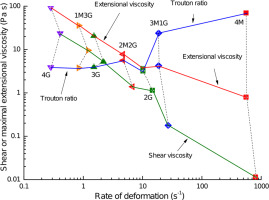当前位置:
X-MOL 学术
›
Food Hydrocoll.
›
论文详情
Our official English website, www.x-mol.net, welcomes your
feedback! (Note: you will need to create a separate account there.)
Rheological investigations of beta glucan functionality: Interactions with mucin
Food Hydrocolloids ( IF 11.0 ) Pub Date : 2019-02-01 , DOI: 10.1016/j.foodhyd.2018.07.049 Bo Yuan , Christos Ritzoulis , Jianshe Chen
Food Hydrocolloids ( IF 11.0 ) Pub Date : 2019-02-01 , DOI: 10.1016/j.foodhyd.2018.07.049 Bo Yuan , Christos Ritzoulis , Jianshe Chen

|
Abstract The shear and extensional rheology of β-glucan and mucin mixtures have been studied as to probe the functionality-related thickening effects of consumed β-glucan during food digestion. Mucins, the main viscosity-inducing components of oral and gastrointestinal fluids, can increase the shear viscosity of β-glucan solutions, e.g. when 3% mucin is added into 1% β-glucan, the shear viscosity increases from 0.4 Pa s (1% β-glucan) to 2 Pa s at a shear rate of 0.1 s−1. The 3% mucin contributes 1.6 Pa s in the presence of β-glucan, which is nearly 16 times of the viscosity induced by 4% mucin alone at the same shear rate. Mucin affects the extensional viscosity in a similar way, e.g. incorporation of 2% mucin into a 2% β-glucan system increases the extensional viscosity from 4 Pa s to 8 Pa s. Substitution of β-glucan for an equal concentration of mucin results in the decrease of the shear and extensional viscosities: Α 4% β-glucan solution has a maximum extensional viscosity of 92 Pa s; substitution of 1% β-glucan for 1% mucin (1% mucin+3% β-glucan) reduces the maximum recorded extensional viscosity to 36 Pa s; this is further reduced down to 8 Pa s at 2% mucin+2% β-glucan, and then on to 4 Pa s at 3% mucin+1% β-glucan, and to 0.8 Pa s at 4% mucin. A similar trend is observed for the shear viscosities. The shear and extensional moduli and the extensional relaxation times also follow such patterns. The Trouton ratio values are lower than 100, that is they are not as high as in other food hydrocolloids; this strongly suggests a fine in vivo interplay between shear and extensional viscosities. The effect of mucin on β-glucan solutions rheology is primarily attributed to excluded-volume interactions, which increase the effective concentration of the glucans. The implications of the above on the rheology-related functionality of β-glucans are discussed.
中文翻译:

β-葡聚糖功能的流变学研究:与粘蛋白的相互作用
摘要 β-葡聚糖和粘蛋白混合物的剪切和拉伸流变学已被研究,以探讨食物消化过程中消耗的 β-葡聚糖的功能相关增稠效应。黏蛋白是口腔和胃肠液的主要致粘成分,可以增加 β-葡聚糖溶液的剪切粘度,例如当 3% 的粘蛋白加入 1% β-葡聚糖时,剪切粘度从 0.4 Pa s (1% β-葡聚糖)在 0.1 s-1 的剪切速率下达到 2 Pa s。在β-葡聚糖存在的情况下,3% 的粘蛋白贡献了 1.6 Pa s,几乎是相同剪切速率下单独 4% 粘蛋白诱导的粘度的 16 倍。粘蛋白以类似的方式影响拉伸粘度,例如将 2% 的粘蛋白掺入 2% 的 β-葡聚糖系统将拉伸粘度从 4 Pa s 增加到 8 Pa s。用相同浓度的粘蛋白代替 β-葡聚糖导致剪切和拉伸粘度降低:A 4% β-葡聚糖溶液的最大拉伸粘度为 92 Pa s;用 1% β-葡聚糖代替 1% 粘蛋白(1% 粘蛋白 + 3% β-葡聚糖)将记录的最大拉伸粘度降低至 36 Pa s;在 2% 粘蛋白 + 2% β-葡聚糖时进一步降低至 8 Pa s,然后在 3% 粘蛋白 + 1% β-葡聚糖时降至 4 Pa s,在 4% 粘蛋白时降至 0.8 Pa s。对于剪切粘度观察到类似的趋势。剪切和拉伸模量以及拉伸弛豫时间也遵循这种模式。Trouton 比率值低于 100,即它们不如其他食品水解胶体高;这强烈表明剪切和拉伸粘度之间存在良好的体内相互作用。粘蛋白对 β-葡聚糖溶液流变学的影响主要归因于排除体积相互作用,这增加了葡聚糖的有效浓度。讨论了上述对 β-葡聚糖的流变学相关功能的影响。
更新日期:2019-02-01
中文翻译:

β-葡聚糖功能的流变学研究:与粘蛋白的相互作用
摘要 β-葡聚糖和粘蛋白混合物的剪切和拉伸流变学已被研究,以探讨食物消化过程中消耗的 β-葡聚糖的功能相关增稠效应。黏蛋白是口腔和胃肠液的主要致粘成分,可以增加 β-葡聚糖溶液的剪切粘度,例如当 3% 的粘蛋白加入 1% β-葡聚糖时,剪切粘度从 0.4 Pa s (1% β-葡聚糖)在 0.1 s-1 的剪切速率下达到 2 Pa s。在β-葡聚糖存在的情况下,3% 的粘蛋白贡献了 1.6 Pa s,几乎是相同剪切速率下单独 4% 粘蛋白诱导的粘度的 16 倍。粘蛋白以类似的方式影响拉伸粘度,例如将 2% 的粘蛋白掺入 2% 的 β-葡聚糖系统将拉伸粘度从 4 Pa s 增加到 8 Pa s。用相同浓度的粘蛋白代替 β-葡聚糖导致剪切和拉伸粘度降低:A 4% β-葡聚糖溶液的最大拉伸粘度为 92 Pa s;用 1% β-葡聚糖代替 1% 粘蛋白(1% 粘蛋白 + 3% β-葡聚糖)将记录的最大拉伸粘度降低至 36 Pa s;在 2% 粘蛋白 + 2% β-葡聚糖时进一步降低至 8 Pa s,然后在 3% 粘蛋白 + 1% β-葡聚糖时降至 4 Pa s,在 4% 粘蛋白时降至 0.8 Pa s。对于剪切粘度观察到类似的趋势。剪切和拉伸模量以及拉伸弛豫时间也遵循这种模式。Trouton 比率值低于 100,即它们不如其他食品水解胶体高;这强烈表明剪切和拉伸粘度之间存在良好的体内相互作用。粘蛋白对 β-葡聚糖溶液流变学的影响主要归因于排除体积相互作用,这增加了葡聚糖的有效浓度。讨论了上述对 β-葡聚糖的流变学相关功能的影响。







































 京公网安备 11010802027423号
京公网安备 11010802027423号